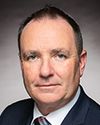Thank you, Mr. Chair.
Good afternoon, all members of the committee.
My name is Godfrey Jerry, and I'm the assistant vice-president of group disability operations at Manulife. I'm responsible for the delivery of the Canadian Armed Forces long-term disability plan, where Manulife is the life insurer and the administrator for long-term disability benefits, along with the vocational rehabilitation program.
I'm located in beautiful Halifax, Nova Scotia, and oversee 230-plus employees nationally, with the bulk of our employees in Nova Scotia who support the CAF long-term disability plan. I have been with Manulife for over 21 years.
I would also like to thank you for the invitation to appear before the committee today. I apologize that I have to leave early, but I have some parental duties that I must attend to.
Joining me today is my colleague, Maureen McGrath. Maureen is the national manager of the Canadian Armed Forces long-term disability vocational rehabilitation program. Maureen has been involved with this program for the past 34 years.
I just want to share with you that 53% of all Manulife employees who support the Canadian Armed Forces long-term disability vocational rehabilitation program are bilingual. Forty per cent of our vocational rehabilitation counsellors are veterans themselves, and 54% of our counsellors are women.
Manulife is Canada's largest life insurance company. We have over 26,000 Canadian businesses and organizations that entrust us with their group insurance needs. We appreciate the trust and partnership we have with the Canadian Forces Morale and Welfare Services, the Department of National Defence and the Canadian Armed Forces when it comes to this plan.
The CAF LTD plan is a key component of the Canadian Armed Forces' suite of group benefits. It provides ill and injured veterans with income and vocational rehabilitation support after their release. It provides up to 75% of the member's salary at the release from the Canadian Armed Forces for both service-related and non-service-related illnesses and injuries. It is a disability insurance program that provides financial benefits, including vocational rehabilitation, to medically releasing members and to members who take a voluntary release and qualify as totally disabled.
Manulife takes great pride in serving those who have served our country. We work closely and coordinate with the CAF to ensure a smooth transition for ill and injured members. Over the past five years, 84.6% of plan members were pre-approved for long-term disability benefits and were referred to a vocational rehabilitation program prior to their medical release from the CAF. Within five days of the receipt of the final claim requirements, 95.5% of plan members received their long-term disability benefits. Each month, over 12,000 veterans receive a benefit payment from Manulife under this program.
This also includes 2,000 new claims that we receive each year for benefits and vocational assistance. One out of five of those claims is for a woman, and 97.5% of veterans are contacted by our in-house vocational rehabilitation counsellor at Manulife within five business days of a referral. Manulife works very closely with SISIP Financial, the director general compensation and benefits with the Department of National Defence, and the CAF transition group to ensure open communication and collaboration. Our employees take great pride in our service delivery, and I can confirm that there are no backlogs or service issues when it comes to the Canadian Armed Forces long-term disability program, as well as the vocational rehabilitation program.
We understand that the focus today is on the experience of women veterans.
Women veterans who are in receipt of Canadian Armed Forces long-term disability benefits do not have the option to return to work with their former employer. After their release, they will be preparing to make the transition to employment as a civilian in an entirely new work environment with new colleagues. Their transition will require them to successfully adapt to a new workplace culture while navigating the potential complexity and impact of their illness and injury.
As part of their transition, like all veterans, women veterans leaving the forces experience a mix of emotions. For many members, if not most, being in the Canadian Armed Forces is central to the way they have lived for many years. It is unlike other professions and careers. They have to leave their place of work and, in many cases, the supports and the structure that being in the forces provides. They're also leaving their friends and colleagues.
Depending on members' ranks, trades and injuries, their transferable skills may or may not easily carry over to civilian employment. There may be an upgrading of skills required, such as securing civilian certifications and, in some cases, training towards an entirely new field to acquire new skill sets that will allow them to be competitive in the work marketplace.
Helping women veterans transition to civilian careers is one of the many ways in which Manulife provides support. Through the CAF LTD vocational rehabilitation program, women veterans have early access to education funding to help develop skills that will make them competitive in the marketplace. The voluntary program is available to all members who have been approved for LTD benefits. It does not distinguish whether the illness or injury is service-related or causing a barrier to re-establishment.
Members may begin active participation in the Canadian Armed Forces long-term disability vocational rehabilitation program in the six months prior to their medical release. They have access to funds for tuition, books, allowances to travel to school, school supplies and other program-required equipment and dependent care. Through our plan and program, our dedicated case manager team and vocational rehabilitation specialists provide support to releasing veterans to help guide them through their transition needs.
More broadly, Manulife supports Soldier On, the Canadian Armed Forces program that is contributing to the recovery of ill and injured women soldiers and veterans through grants towards improving health outcomes. In 2022 we contributed to over 130 Soldier On grants. In the past four years, we've helped with 500 grants that have been given to those women soldier veterans.
Thank you for your invitation for us to speak with you today. Maureen and I appreciate the opportunity to support the work of your committee.









